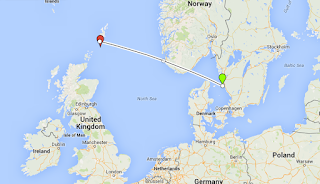14th-25th April
 |
| Shag on nest, we're all hoping for a breeding season as good as the last one... |
A long time since an update, but not a huge amount to report. I'm currently looking after Freyja who's down with a cold and I'm starting getting some feeling back into my face and fingers after censusing Buness and the Havens and doing the Beached Bird Survey this morning in a rather cold NW wind. Once Susannah's back from Kirk, I'll be heading out round the rest of North, which I'm not expecting to be an entirely enjoyable experience!
 |
| Shetlantarctica. The scene on Saturday as winter returned to the Northern Isles, although we got away with just a few wintry showers on Fair Isle. |
The recent period has seen largely westerly winds, with a calmer period over 17th-20th that brought a few more signs of spring, but with north-west winds dominating the forecast for the foreseeable future, it looks like the early part of this spring is going to be a real contrast with the amazing spell of late-April migration last year.
 |
| Calm weather was enough to encourage the family down south for a picnic, and was even nice enough for coats to be shed (although not the wooly hats!). |
We've not been without a few highlights though, chief of which was the brief appearance of a pale-bellied Brent Goose in South Haven on the morning of 25th, the first Brent on the island since spring 2010. A general theme of the highlights not being passerine-based was continued with the arrival of first one, then three, then five Gadwall from 20th-22nd, sadly the increase didn't continue and we were left with just the second-largest ever Fair Isle flock. I've mentioned before the 'island-network' of news, and it's interesting that Noss and the Isle of May have both recorded Gadwall in the last week, islands where they are even greater rarities than Fair Isle. It's the sort of species that doesn't feature on Birdguides, so perhaps a larger than normal movement of them wouldn't get picked up so easily - anyone else out there recorded Gadwall on their patch when they didn't expect it? Other wildfowl have been generally thin on the ground, although the first Whooper Swan of the year appeared from 21st and a couple of Pink-footed Geese have also passed through.
 |
| Two of the Gadwall being photobombed by the still present Mute Swan. I wonder if the swan hangs on until the autumn and gives a few of our regulars a Fair Isle tick? It seems to have made friends with the Whooper Swan recently, which could be interesting... |
Other avian highlights have included a smart breeding-plumaged Slavonian Grebe (19th-23rd), only the 5th spring record in the last 18 years of this species which is a more regular autumn visitor.
 |
| The rather smart Slavonian Grebe, it could be watched chasing fish underwater in the clear waters of the North Haven, where it moved with impressive speed. |
Wader passage has brought the first Whimbrel (16th), Knot (17th), Greenshank (18th), Black-tailed Godwit and Common Sandpiper (both 19th) of the year, with the first Arctic Skua of the year returning on 25th. Other migrants have largley turned up despite the weather rather than because of it and numbers haven't been great as we've been relying on the brave (or foolish) individuals that have pressed on regardless. First arrivals have been represented by Willow Warbler (14th, with just a few after that), Blackcap (18th, with no more than two since), Tree Sparrow (a flock of 3 that arrived on 20th at the Obs and increased to 5 two days later), House Martin (21st), Sand Martin (22nd), Grasshopper Warbler, Tree Pipit and 2 Kestrel (all of which turned up in unpromising westerly winds on 25th).
 |
| A few White Wagtails have been passing through, as well as a few 'Greenland' Wheatears, both typical migrants in westerly winds. |
One thing that isn't weather dependent is the arrival of cetaceans and after three unidentified dolphins were seen on 19th, we got the one that most people were after - Killer Whales. Initially seen by Jane as she was searching for colour-ringed Starlings in South Harbour, the three animals (including two adult bulls), moved up the east coast, with the rest of the Obs team (well, all of the team except me, as the sighting occurred at exactly the time I was called up to the airstrip for fire duty for the incoming plane) able to get out onto Buness or Roskillie to get good views as they went past.
.png) |
| Killer Whale photographed by island resident Joe Butler with his phone as it swam under the cliffs at Buness. |
Interestingly, one of the bulls had a fin that was totally collapsed to the right hand side, exactly the same as one that spent several hours off Fair Isle in a group of 15 animals in June 2013, there has to be the chance that the same animal is involved in both sightings (although unfortunately, it wasn't photographed on this occasion).
So, it just goes to show that it's always worth being out there, whatever the weather - and if we keep telling ourselves that in the next 10 days of westerlies, we might start to believe it!








































.png)
.jpg)




.JPG)
.jpg)
.jpg)
.jpg)